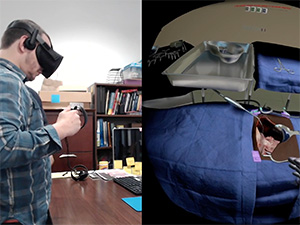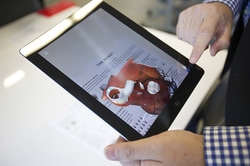Lab Overview
The Olamaie Curtiss Graney Design Lab focuses on the application of immersive and engaging technology in teaching and learning. Our primary focus is on the application of Virtual Reality, Augmented Reality, and Game-based Learning.
Virtual Reality
 Virtual Reality (VR) is the use of computer technology to create a simulated environment. Unlike traditional user interfaces, VR places the user inside an experience. Instead of viewing a screen in front of them, users are immersed and able to interact with 3D environments. By simulating as many senses as possible, such as vision, hearing, touch, even smell, the computer is transformed into a gatekeeper to this artificial world. VR is an immersive media that relies on three-dimensional imagery, spatialized sound, and virtual touch make the virtual world seem pretty compelling.
Virtual Reality (VR) is the use of computer technology to create a simulated environment. Unlike traditional user interfaces, VR places the user inside an experience. Instead of viewing a screen in front of them, users are immersed and able to interact with 3D environments. By simulating as many senses as possible, such as vision, hearing, touch, even smell, the computer is transformed into a gatekeeper to this artificial world. VR is an immersive media that relies on three-dimensional imagery, spatialized sound, and virtual touch make the virtual world seem pretty compelling.
Surgery Simulator - Oculus Rift
The Virtual Reality Surgery Simulator (VRSS) project aims to reduce the time and cost required to train surgeons by using virtual reality surgical simulation training in conjunction with remote real-time supervision of surgical trainees.
Augmented Reality
 Unlike virtual reality, which creates a totally artificial environment, augmented reality uses the existing environment and overlays new information on top of it. Boeing researcher Thomas Caudell coined the term augmented reality in 1990, to describe how the head-mounted displays that electricians used when assembling complicated wiring harnesses worked. One of the first commercial applications of AR technology was the yellow "first down" line that began appearing in televised football games sometime in 1998.
Unlike virtual reality, which creates a totally artificial environment, augmented reality uses the existing environment and overlays new information on top of it. Boeing researcher Thomas Caudell coined the term augmented reality in 1990, to describe how the head-mounted displays that electricians used when assembling complicated wiring harnesses worked. One of the first commercial applications of AR technology was the yellow "first down" line that began appearing in televised football games sometime in 1998.
Learning High School Geometry - Hololens
This interdisciplinary grant proposal seeks to build and test a “proof of concept” prototype of an augmented reality simulation environment for learning high school geometry. This grant is a collaboration between a faculty member in the Simmons School of Education and Human Development (Candace Walkington) and a faculty member in the SMU Guildhall Videogame Design Program (Elizabeth Stringer). With this grant, we seek to: (1) Design geometry simulations that utilize the Microsoft HoloLens 2 Augmented Reality (AR) system, (2) Create simulations that allow for hands-free, collaborative (multi-person) coordinated manipulations of geometric objects, (3) Test the simulation’s usability with pairs of middle and high school students working together to explore a single virtual geometric object, and (4) Assess what participants learn about geometry from using the simulation.
STEM Simulations - Magic Leap and Oculus Quest
The STEM Simulation Library project is designed to demonstrate opportunities to teach abstract STEM concepts with the immersive and interactive capabilities of AR/VR Headsets. We are working with Teachers and Students to design sample simulations to teach concepts such as Molecular Shapes and Projectile Motion in AR/VR.
Game-based Learning Applications
Game-based learning has been shown to be significantly enhance student learning when integrated appropriately into instruction. An SRI meta-analysis (2014) highlighted evidence that the more sessions that students play educational games, the greater the advantage they gain over their peers who are not provided games as part of their course. The analysis also investigated the hypothesis that games encouraging multi-player collaboration would be more effective than single-player games and found that collaborative competitive games and single-player games that lacked a competitive element were both more effective than single-player competitive games. While other game based learning research studies have found that “non-game instruction” would enhance the educational effects of the gameplay, the meta-analysis did not find evidence that additional instruction made a significant difference.
Source: Clark, D., Tanner-Smith, E., & Killingsworth, S. (2014). Digital games, design and learning: A systematic review and meta-analysis [Executive Summary]. Menlo Park, CA: SRI International. Retrieved from https://www.sri.com/sites/default/files/publications/digital-games-design -and-learning-executive_summary.pdf.
Codex Lost Words of Atlantis - Android
A puzzle-solving smartphone game designed by SMU and Literacy Instruction for Texas (LIFT) experts to teach struggling adults to read was today named one of five finalists in an international competition. Codex: The Lost Words of Atlantis is a finalist for the $7 million Barbara Bush Foundation Adult Literacy XPRIZE presented by Dollar General Literacy Foundation.A recent pilot study at SMU found that low-literate, English-language learner adults who played the game for two or more hours a week significantly improved their literacy skills after eight weeks. Anecdotal evidence also shows their improved reading skills also have improved their lives, ranging from a grandmother who finally gained the confidence to speak with her granddaughter in English, to co-workers who praised a participant's improved language skills.
“Clearly we are very proud to have advanced in this important competition,” says Stephanie Knight, dean of SMU's Simmons School of Education and Human Development, which provided faculty expertise in the literacy and instructional design of the game. “We are committed to finding a successful, accessible teaching tool for low-literacy adults. And we know we are on the right track when we hear that one of our study participants gets to hear her children clap every time her reading skills improve enough for her to advance in the game.”
Visit the PeopleForWords website for more information about the Codex app.

